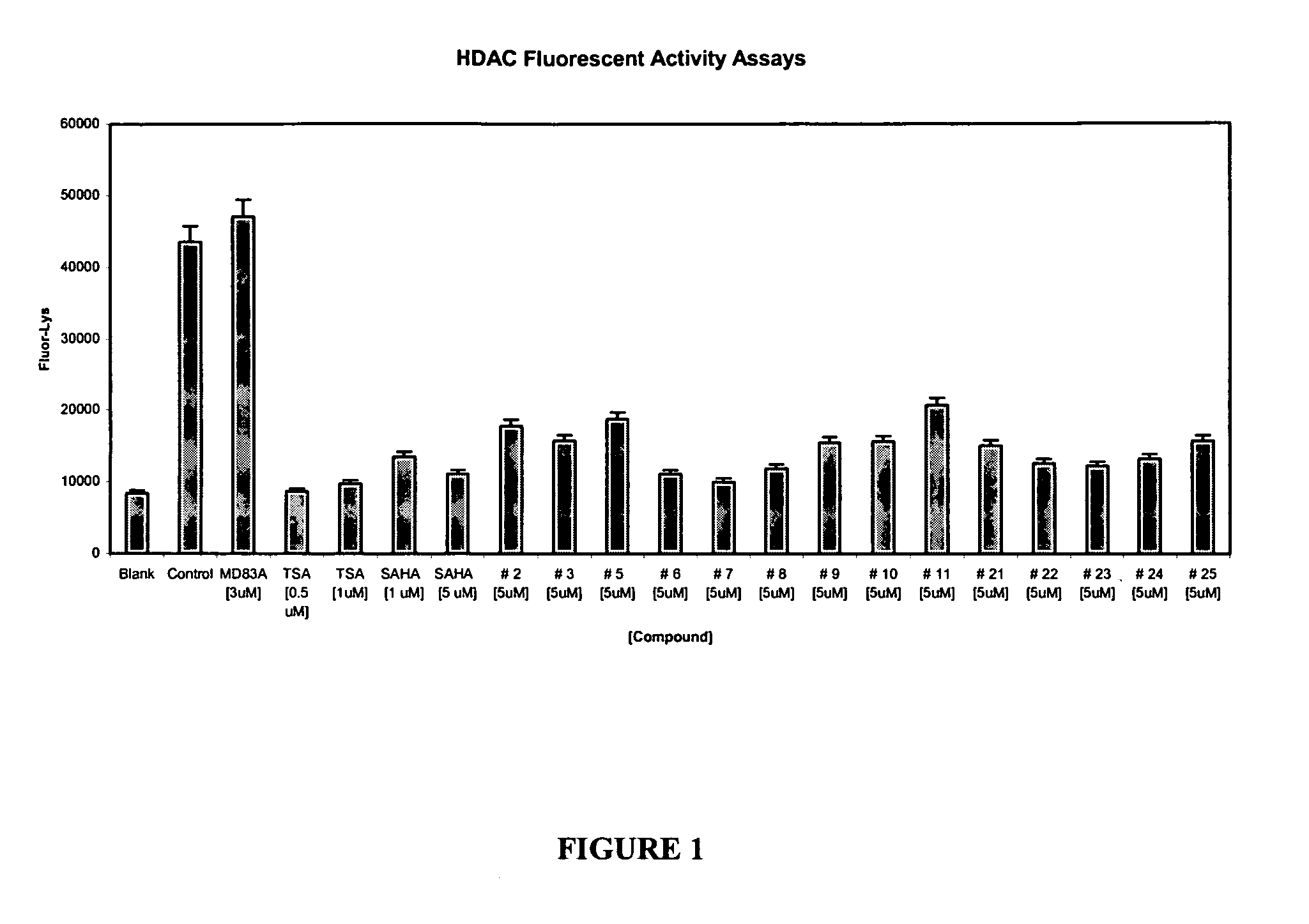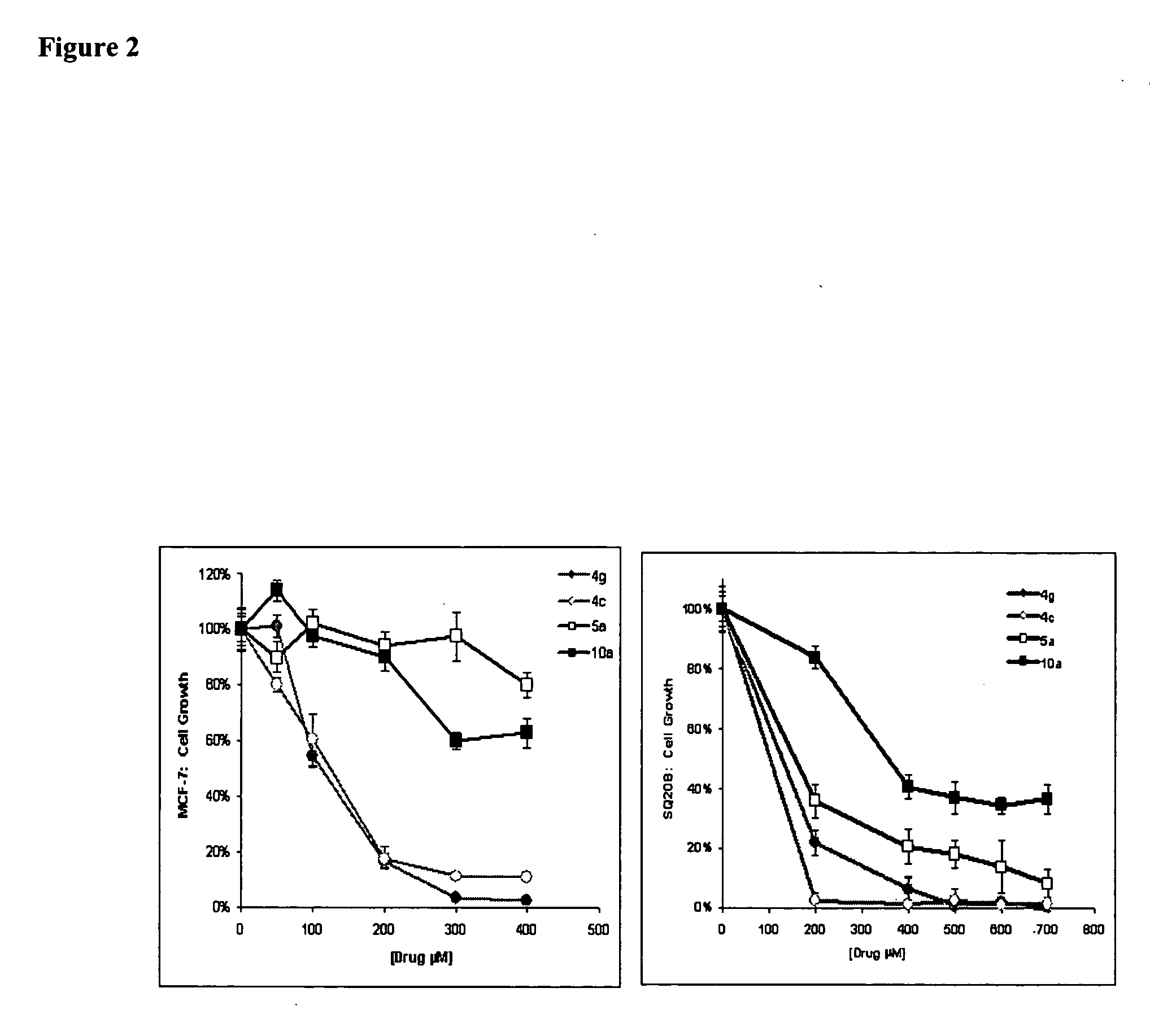Histone deacetylase inhibitors and methods of use thereof
a technology of histone deacetylase and inhibitors, which is applied in the direction of heterocyclic compound active ingredients, biocide, drug compositions, etc., can solve the problems of reducing the sensitivity of cancer cells, and affecting the effect of chemotherapy
- Summary
- Abstract
- Description
- Claims
- Application Information
AI Technical Summary
Benefits of technology
Problems solved by technology
Method used
Image
Examples
example 1
Preparation of 4-[3-(4-Dimethylamino-benzyl)-ureido]-N-hydroxy-butyramide (2)
4-[3-(4-Dimethylamino-benzyl)-ureido]-butyric acid benzyl ester
To a vigorous stirred suspension of 4-amino-butyric acid benzyl ester toluene-4-sulfonic acid (0.730 g, 2.00 mmol) and triphosgene (0.200 g, 0.667 mmol) in dichloromethane (40 mL) at −78° C. under nitrogen atmosphere, was added triethylamine (1.0 mL, 7.188 mmol, in 10 mL dichloromethane) dropwise via an additional f unnel over a period of 2 hours. The cooling bath was removed and the resulting reaction was allowed to stir at room temperature for 1 hour, after which time 4-dimethylaminobenzylamine dihydrochloride (0.446 g, 2.00 mmol) was added to the reaction mixture, followed by triethylamine (0.67 mL, 4.8 mmol). The resulting reaction was allowed to stir for about 18 h, then the reaction mixture was diluted with brine (20 mL), transferred to a separatory funnel and the aqueous layer was extracted with dichloromethane. The organic layer wa...
example 2
Preparation of 5-[3-(4-dimethylamino-benzyl)-ureido]-pentanoic acid hydroxyamide (3)
Compound 3 was prepared using the methodology described for the preparation of compound 2, by substituting 4-amino-butyric acid benzyl ester toluene-4-sulfonic acid with 5-amino-pentanoic acid benzyl ester toluene-4-sulfonic acid. 1H NMR (300 MHz, DMSO-d6) δ (ppm) 10.35 (br s, 1H), 8.68 (br s, 1H), 7.06 (d, J=8.7 Hz, 2H), 6.67(d, J=8.7 Hz, 2H), 6.07 (t, J=5.4 Hz, 1H), 5.84 (t, J=5.4 Hz, 1H), 4.05 (d, J=6.0 Hz, 2H), 2.97 (dt, J=6.6, 6.3 Hz, 2H), 2.84 (s, 6H), 1.94 (t, J=7.2 Hz, 2H), 1.47 (m, 2H), 1.32 (m, 2H). 13C NMR (75 MHz, DMSO-d6) δ (ppm) 168.7, 157.7, 149.2, 128.0, 127.7, 112.1, 42.2, 40.0, 38.6, 31.7, 29.4, 22.3.
example 3
Preparation of 6-[3-(4-dimethylamino-benzyl)-ureido]-hexanoic acid hydroxyamide (4)
Compound 4 was prepared using the methodology described for the preparation of compound 2, by substituting 4-amino-butyric acid benzyl ester toluene-4-sulfonic acid with 6-amino-hexanoic acid benzyl ester toluene-4-sulfonic acid. 1H NMR (300 MHz, DMSO-d6) δ (ppm) 10.34 (br, s, 1H), 8.67 (br s, 1H), 7.06 (d, J=8.7 Hz, 2H), 6.67 (d, J=8.7 Hz, 2H), 6.05 (t, J=5.7 Hz, 1H), 5.80 (t, J=5.7 Hz, 1H), 4.05 (d, J=6.3 Hz, 2H), 2.97 (dt, J=6.6, 6.3 Hz, 2H), 2.85 (s, 6H), 1.93 (t, J=7.5 Hz, 2H), 1.48 (m, 2H), 1.34 (m, 2H), 1.22 (m, 2H). 13C NMR (75 MHz, DMSO-d6) δ (ppm) 168.7, 157.7, 149.2, 128.0, 127.7, 112.1, 42.2, 40.0, 38.9, 31.9, 29.5, 25.7, 24.6.
PUM
| Property | Measurement | Unit |
|---|---|---|
| resistance | aaaaa | aaaaa |
| heterogeneity | aaaaa | aaaaa |
Abstract
Description
Claims
Application Information
 Login to View More
Login to View More - R&D
- Intellectual Property
- Life Sciences
- Materials
- Tech Scout
- Unparalleled Data Quality
- Higher Quality Content
- 60% Fewer Hallucinations
Browse by: Latest US Patents, China's latest patents, Technical Efficacy Thesaurus, Application Domain, Technology Topic, Popular Technical Reports.
© 2025 PatSnap. All rights reserved.Legal|Privacy policy|Modern Slavery Act Transparency Statement|Sitemap|About US| Contact US: help@patsnap.com



